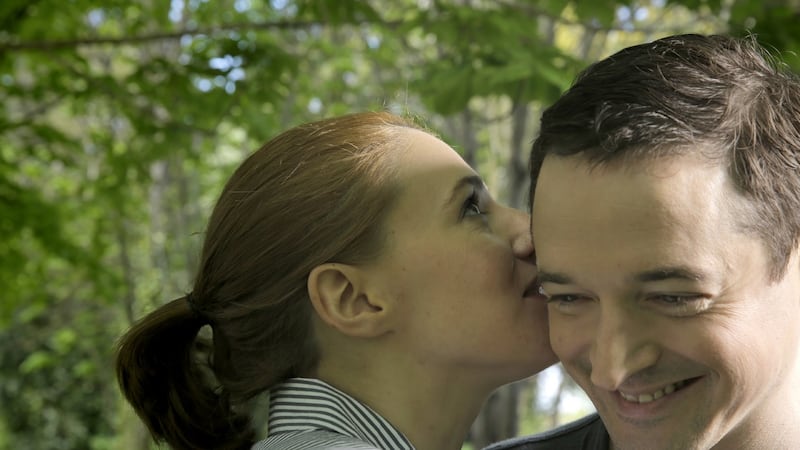If you find yourself in the middle of Dublin with a few minutes to kill, you should visit the National Gallery and steal a look at a woman who will not return your gaze. This, according to her name badge, is Rebecca, a young Nigerian woman sitting in the nowhere space of an airport terminal. It is an appropriate location because Rebecca seems to be somewhere else entirely; her employer’s lanyard dangles over an open white shirt collar, unfolding like a lily, and her eyes have settled on a point far beyond the frame of the photograph. The image, Beckah, is exquisite and intriguing.
When it was first revealed at the gallery, two years ago, a couple stood in front of the picture and mused about Beckah’s secret. “I wonder what she’s thinking?” They turned around to find Beckah standing next to a young man. “I was thinking when my break was going to be,” Beckah told them. Standing next to her was Beckah’s photographer, who might have been familiar. Because Hugh O’Conor – an acclaimed film actor from the age of 10, an award-winning stage actor, a writer and director of short films, a video designer for theatre and a director of music videos – has spent his life in a stream of images. He is used to observing and to being observed.
“It’s a stolen moment,” he said of the photograph, which was shortlisted for the Hennesy Portrait Prize. “You’re freezing time. That’s why it can seem mysterious, I suppose.”

Gently spoken, unswervingly good- natured, contagiously enthusiastic and still boyishly handsome at the age of 40, O’Conor doesn’t strike you as a person likely to steal anything, not even a moment. Like many of his photographs, and indeed even his roles, Beckah’s portrait hovers between something candid and carefully composed. He sought permission before taking it and suggested simply that she look out the window. It adds to the texture of the image that she knows she is being watched.
In Enda Walsh's new play, Arlington: A Love Story, for Landmark Productions and Galway International Arts Festival, O'Conor plays another watcher, known in the text as the Young Man, who arrives in an anxious flap to monitor a Young Woman, played by Charlie Murphy, who has been trapped in a waiting-room, in a tower, and observed for her entire life.
It was written in three quick weeks and developed from a short piece that Walsh wrote earlier this year for Fighting Words and The Irish Times, and extends the playwright’s claustrophobic fixations with sealed spaces that fill with frantic words and frazzled performances. But if Arlington invites yet more comparisons to Beckett (an electronic display and the young woman’s astronomical ticket number underline her interminable waiting), Walsh’s allusions to the Syrian crisis, to images of displacement and isolation, power and control, may make it his most overtly political play.
O’Conor’s approach to performance is thorough, intellectual and quite sly. A voracious reader, he tends to first busy himself in research. For his award-winning performance as the Fool in Selina Cartmell’s production of King Lear for the Abbey, for instance, he read around the role extensively, watched every recorded performance available, made surprising associations, and created a figure both otherworldly and rooted – a combination, he now says, of Blackadder’s bitterness and Baldrick’s innocence. With Arlington, his inspiration seems to have begun somewhere closer.
“I’m being, like, really good at the moment,” he says in a mock Californian accent as he orders a virtuous salad. “I just thought I should be really skinny for the part. And quite nerdy. I’m wearing glasses at the moment in rehearsals.”
This sounds like someone we know. “It is weirdly a little bit like Enda, without my ever meaning it to,” he says. But Walsh – also eternally boyish, wiry and expressive – started out as a performer, and O’Conor recognises another actor when he sees one. “That’s why he is such a good director: because he appreciates what you’re going through. Sometimes I just watch him, because he naturally physicalises it.”
There’s every temptation to see the Young Man, who begins the play as a nervy observer and later becomes trapped in its surreal, oppressive world, as the playwright’s self-portrait.
O'Conor has a disarming tendency to illustrate his conversation with photographs, sometimes even with the description of a photograph. Brimming with anticipation for The Overcoat – an animated film version of a Gogol story he has adapted and which he has been trying to make for at least 17 years – he shows me image after image: a mock still of a grandfather (voiced by Alfred Molina) telling the story to his grandson; a charming spread of each character's whimsical appearance; a picture of Cillian Murphy recording his part in a sound studio.
Another shows Enda Walsh, reclining on a plastic chair, as stiff as an ironing board, and peering with utmost scepticism into a book titled The Theatre of Enda Walsh, which O'Conor gave him as a gift. It is hard to imagine a more accurate portrait of Walsh. What was he thinking, I wonder? "He said he's going to give it to Jo, his wife, to read, and maybe leave it in the loo."
O’Conor considers his photography “just sort of a side thing”, but his work has been exhibited in the RHA, Rua and the National Gallery, and his ability to compose or capture a revealing image is hard to put down to a hobby. His collection of dressingroom portraits of actors immediately after – or shortly before – delivering performances for the arts anthology Winter Pages is a fascinating and beautiful document of people who seem neither quite on or off: Andrew Scott alone in his dressingroom after Sea Wall; Aoife Duffin laying down her head after A Girl Is a Half-Formed Thing; the four female cast members of Lippy each at a separate mirror in a tunnel of introspection. They all seem comfortable being watched.
If Irish theatre has become more imagistic, more pictorial, O’Conor has been there to assist, using his film experience to design video refractions for Marina Carr’s 16 Possible Glimpses, or a backdrop of public surveillance for Mark O’Rowe’s version of Hedda Gabler, both at the Abbey.
He agrees that his early exposure to film acting may have shaped his ways of seeing things. “There is a photo of me, when I was doing Lamb [Colin Gregg’s dark drama from 1985, in which O’Conor starred opposite Liam Neeson], where I’m at this big film camera, in a train station somewhere, looking through the viewfinder. I was so excited being able to look through the camera. So I definitely got a bug for that.” It’s not always easy to say whether O’Conor is describing a picture or a memory.
When accepting the Oscar for My Left Foot, in 1990, Daniel Day-Lewis began with a sincere tribute to a collaboration: “I got to share Christy’s life for a while with a remarkable young actor called Hugh O’Conor,” he began, and the auditorium filled with applause. People invariably talk about the “difficult transition” from child acting to acting, but O’Conor, who was discovered in Betty Ann Norton’s theatre school, worked steadily ever since his debut, without interrupting his education. He studied theatre in Trinity College Dublin, then went to film school in New York University. “I definitely wasn’t against it,” he says of acting early, “but I didn’t naturally want to do it.”
Again he sounds like an outside observer, pitching an idea: “That would be such an interesting story about child actors,” he says, “having come from there myself. It’s an interesting world. Whether you buy into the fantasy of it or the reality.”
His work, you suspect, is always somewhere in between the two. He prefers to photograph real people rather than models, for instance, but takes care to frame them. He is entirely unprecious about the artifice that goes into creating convincing portrayals: “Maybe don’t say this, but I’m reading a book on acting at the moment, just to remind myself,” he laughs. “It’s Declan Donnellan’s The Actor and the Target, it’s actually really beautiful.” And, as someone accustomed to being looked at, he is aware that in these watchful times everyone is caught in some kind of a performance. “You know yourself, you don’t want to feel like you’re acting all the time, but we all kind of do.”
That seems to be as true for Beckah, the monitored figures in the theatre of Enda Walsh, or, indeed, for O’Conor, the most observed of observers. As our interview ends, I ask if I can take his photograph. He doesn’t seem to mind.
- Arlington: A Love Story is at Leisureland, Galway, July 7th-24th, as part of Galway International Arts Festival. giaf.ie




















